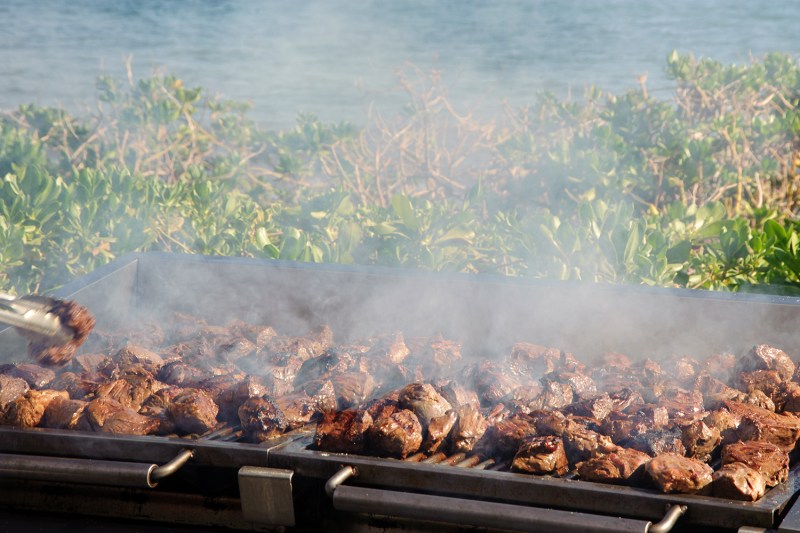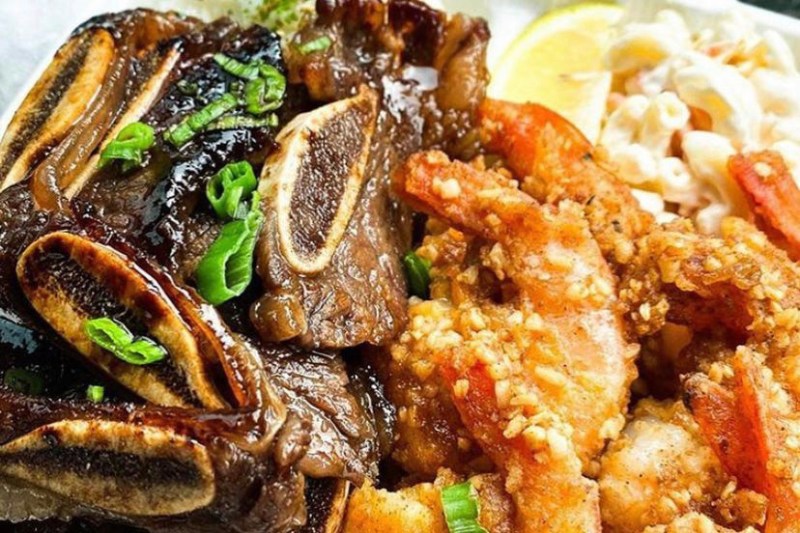
Hawaii island is an enchanting archipelago painted with beaches, rainbows, and volcanoes. It’s also home to some delicious food, from shave ice and loco moco to poke and spam musubi.
When it comes to island grub, Hawaiians specialize in barbecue. Maybe it’s the weather and the engrained sense of outdoor culture. Maybe it’s the appreciation of barbecue-friendly meats like chicken, pork, and seafood. Certainly, it’s a tradition inherited from other nations of the Pacific and adapted into something very Hawaiian.
Tryzen Patricio runs the incredibly popular Hawaiian restaurant GrindWitTryz. What began as a food cart has blossomed into a brick-and-mortar spot in Patricio’s adopted home of Portland. And now the restaurant is located in a bigger space in Northeastern Portland. An Oahu native, Patricio grew up around Hawaiian barbecue.
“Hawaiian BBQ to us is basically a pāʻina or party,” he said. “It’s a time where everyone comes over, brings over food to share with everyone, whether it’s something to grill or even something you possibly bought and just grind! We drink and talk stories all night enjoying the comfort of each other. This is always the best way to kick back and enjoy the hard working week we had.”
A lot of what’s barbecued in Hawaii ends up on what’s affectionately called “plate lunch.” The term refers to a core meat and a few sides, influenced in a big way by the culinary ways of Polynesia. “Plate lunch is basically all the amazing needs for food in one plate,” Patricio explained. “Most Hawaiian lunch plates will have two sides — rice and mac salad — served with meat. It’s a complete meal if you have a Hawaiian sun to add on to it.”
What Patricio and his team create at GrindWitTryz is very much inspired by the many backyard gatherings of his youth. His favorite BBQ dish is the kalbi short ribs and ribeye steak, a recipe that borrows from Korean food. “These are the dishes that are always guaranteed to be at a get-together with family and friends,” he said. “It brings back so many memories each time we prepare and serve it to our customers.”

The history
Luau culture and Hawaiian barbecue go hand in hand. For generations, Hawaiians have gathered and cooked outside, enjoying the bounty of their surroundings. At first, much of the protein was slow-cooked underground via hot resident rocks (and still is to this day, especially for special occasions). Many of the longstanding dishes have embraced the barbecue technique.
And those dishes are as eclectic as the many kinds of people that make Hawaii what it is today. Even in the barbecue realm, you can detect obvious elements of Chinese, Japanese, Filipino, Polynesian, and Portuguese cooking, just to name a few. The fusion has given rise to a lot of now signature dishes, many of which have crossed the Pacific to the contiguous U.S.
From the day missionaries arrived to the island of Hawai’i, that was the beginning of knowing more people from around the world were about to enter our island,” Patricio said. It began with the sugar plantations, which drew labor from all over the globe. Somehow, a spark came about and all those foods came together creating something amazing,” he said.
“Generally, Hawaiian food was laulau, Kalua pig, poi, haupia and so on. But because more diverse cultures and people have come into our island, Hawaiian food has expanded,” he explained. All of that rubs off on his restaurant’s list of offerings. The inspiration of Kalbi Short Ribs and Meat Jun is originally from Korean culture, the chicken long rice is Chinese, the Okinawan Shoyu Pork is Japanese, and the Pastele Stew is Puerto Rican.
The level of fusion in Hawaiian cuisine is on another plane, making it quite unique. “Certain ethnicities may have a history of differences but, somehow food is what brings everyone together,” Patricio says. He references the writer Sheldon Simon, who likens Hawai’i to a salad bowl. “Each ethnicity that has influenced us has been tossed together but is still distinct in its own way,” he said.

Core dishes
It’s a broad category, but you can’t talk about Hawaiian BBQ without including at least the following items.
Kalua pork
Kalua pork is perhaps the most famous, and now absorbed fully by the tourist trap resort luau. The dish, which involves slow-cooking a whole pig over an imu — or outdoor charcoal grill comprised of flames and heated volcanic rocks — goes way back and can involve boar, of which there are many in Hawaii. The meat is wrapped in banana leaves and buried to cook for almost half a day. The result is succulent meat, often served with poi and other sides.
Huli Huli chicken
Huli Huli chicken is believed to be the product of a Honolulu businessman circa 1955. Very much informed by Asian cuisine, this grilled chicken dish involves a baste of sweet, teriyaki-like sauce, made of some combo of garlic, soy sauce, ginger, pineapple juice, and a sweetener like brown sugar. In Hawaii, the bird is often cooked whole and turned halfway through the process. It’s a delicious mix of sweet, tangy, and umami notes.
Mahi Mahi
Mahi Mahi is one of the most barbecue-friendly and eye-catching fish in all the sea. A Maui-style rendition of the dish has become popular over the years, which involves dressing the fish in butter and garlic before giving it the heat treatment. After, it’s often hit with honey, onion, sesame, lemon, and soy sauce. In a similar vein is garlic shrimp, especially popular along the surfy stretches of the north shore of Oahu. In Hawaii, you’ll often see this dish prepared in a pan, but there are barbecue riffs, too.
Lau Lau
These are steamed taro leaf (ti leaves) packages filled with savory goodness like pork, chicken, or fish and seasoned with Hawaiian salt. The ti leaves impart a subtle earthy flavor and aroma to the dish, while also acting as a natural steamer trap, keeping the Lau Lau moist and flavorful.

Recipes
Sam Choy’s 30-minute Hawaiian marinade for hibachi steak or chicken
Hawaii native Sam Choy is widely regarded as the founder of “Pacific Rim cuisine.” His career began as the chef at the prestigious Waldorf-Astoria Hotel, and in 2004, he was awarded the James Beard Foundation’s America’s Classic Award for his late Kaloka restaurant in Kona, Hawaii. Choy continues to be a prominent fixture on the food circuit, appearing on several Food Network programs. This recipe is fantastic for all kinds of barbecue-able items.
Ingredients:
- 6 chicken breasts or 2-3 pounds of steak (if you can get it sliced super thin, that would be best)
- 1 teaspoon sesame oil
- 1 1/2 cups shoyu (sweetened soy sauce similar to teriyaki but uniquely it’s own flavor)
- 2 cloves garlic, minced
- 1 cup sugar
- 1/4 cup ginger, minced
- 2 tablespoons green onions, thinly sliced
- 1 tablespoon Chinese parsley (otherwise known as cilantro), minced
- 1/8 teaspoon white pepper
Method:
- Prepare your grill or coals on a hibachi.
- Blend marinade ingredients thoroughly, slice your chicken or steak and let marinate for 30 minutes.
- Grill over coals or on your grill, turning after 3 minutes for a total cooking time of 8-10 minutes for the chicken and to your preference for the steak.
Huli Huli chicken
This recipe from Hawai’i Magazine will have you feeling the warmth of summer and eager for backyard gatherings. Try it with a whole or half chicken for best results, but any cut will do.
- 1/3 cup ketchup
- 1/3 cup soy sauce
- 1/4 cup brown sugar
- 1/4 cup honey
- 1/4 cup sherry
- 1-2 tablespoons sesame oil
- 1-2 more pieces ginger root, crushed
- 3 cloves garlic, crushed
- Worcestershire sauce to taste
- Sriracha or Asian chili paste (or red pepper flakes) to taste
Method:
- Combine all ingredients and brush the chicken with the marinade while cooking over a grill.
- lip the chicken about halfway through the grilling process.


